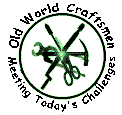| Cedar Siding and Cedar Roofing have been a beautiful mainstay of the natural roofing and siding marketplace for centuries. The qualities of natural Cedar are well known. This writing will concentrate on the fact that depleted old growth Cedar availability along with the push for sustainable forestry has left the wood siding and roofing industries to the only choice, new growth Cedar. With new growth Cedar comes many deficits and information is sketchy for the purchaser of these products. |
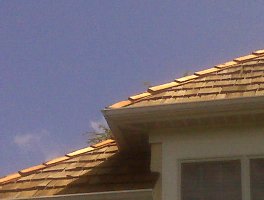 |
New Growth Wood Information
New Growth Wood Phenomena
by Robert Wewer |
15 year New Growth Cedar Wood Roof Repairs to Hip and Ridge Caps - Newtown, Pa. |
| Suppliers, Distributors, Manufacturers and their representatives are without answers to inquiries as to the New Growth dilemma. A mysterious lack of information exists and no one within the industry seems to know or to be willing to speak about the realities that are unfolding before our eyes within the past couple of decades. |
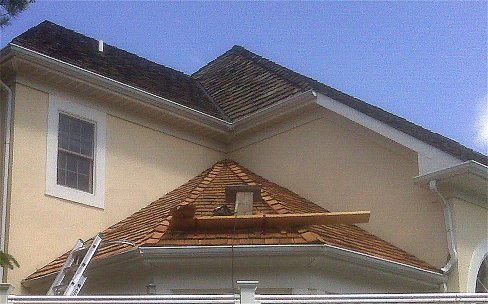 |
New growth wood is now common in the lumber industry and it transcends the framing and cladding product lines. The most significant differences in these new growth products are lack of density and maturity. This paucity in formidably seems to affect the retention of the natural oils and acids, especially in the Cedars. This deficit of new growth Cedar results in a "softness" of the deteriorated wood in 15 to 20 years of weather exposure. It appears that the distance between the rings and the lacking amounts of natural oils and acids contribute to early wood failures when left to the weather. |
15 year old Sectional Cedar Shake Roof replacement. |
| Circa 1940's Old Growth Wood Gutter: Cedar Log Gutter still solid and holding strong! |
Clearly, it is common to find roofing and siding installed after 1987 to have failed. That date in time seems to be representative of the onset of full-blown new growth proliferation in the Cedar siding and roofing marketplaces. It is very easy to discern new growth from old growth wood upon physical inspection of installed product. First, it is highly probable that new growth is present if the date of installation is post 1987. Second and more apparent will be the "softness" of the wood. The ability to push your finger through the wood is a clear indication that you are looking at new growth wood.
New growth wood is a result of forest depletion and an intense drive to save existing old growth woods while providing a sustainable product for the industry. Old growth Cedar is all but depleted in the United States and Canada and Alaska’s remaining old growth forests are the subject of an intense battle.
It is the norm to find old growth Cedar standing over 10 feet in diameter and 160 ft. tall. These trees are estimated to be over 1000 years old. The answer for the industry rose out of a groundswell of well intending environmentalists and lumber personnel. A faster growing tree was necessary to replenish the post WW-II depletion of the forests. Hybrids were developed and reforestry was accomplished and the benefit was seamlessly integrated into the marketplace without question.
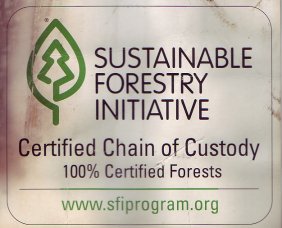 |
|
| A careful review of the information provided on the SFI Program's website leaves the seeker of information in a squirrel-cage of seemingly circular reasoning. The site describes the "Chain of Custody" and the "program" ad nauseam. The information contained on the website is not helpful as to the question regarding the "New Growth" vs. Old Growth" contents packaged beneath the label (shown above). It seems that the Old Growth topic is avoided at all costs. The political hot potato is cooled by endless mumbo-jumbo, but there is a reference that deals with the reforestation issue. |
|
| |
| |
| |
| |
| |
| |
|
|
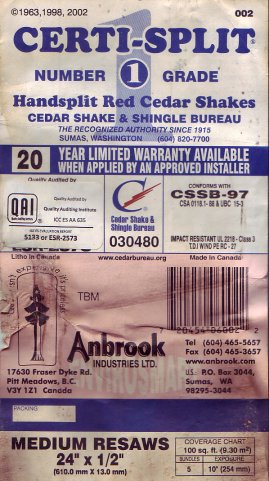 |
It has been argued and done so accurately, that the installation practices since the late 20th century contributed to the demise of Cedar Roofing and Siding. Modern Roofing installation qualms are listed below. As for Siding, the use of rigid foam board insulation and foil facers and wraps under the wood siding has caused Cedar Siding to dry prematurely.
The difference however, in the damage incurred on New Growth and Old Growth is extreme. Old Growth Cedar Siding will stand up to much more and last far longer than New Growth Cedar. |
Label from 20 yr. Shake |
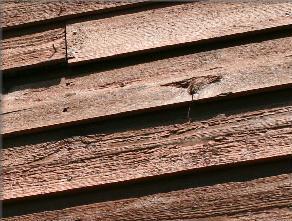 |
| 20
yr. old New Growth Cedar Clapboard |
| |
| |
| |
| |
| All of our clients are made aware of this reality. If your home is leaking from the roof, or a poor grade or application of siding, rot comes on very quickly on new growth wood, even to the New Growth substrate, framing and wood sheathing and trim. Old growth wood however, has a resiliency that is sometimes hard to comprehend. We have worked on homes from the early 1700’s with little or no paint existing on the exterior and zero deterioration was evident from either insect or microbe. By contrast, a twenty year old home can be found rotting away in areas that have succumbed to moisture. Insect infiltration is invited in these circumstances. It seems that the older the wood, the more it will resist all damage from water, rot and insects. |
| |
WOOD GUTTER: 1940's era Cedar Log Gutter still holding up well! |
